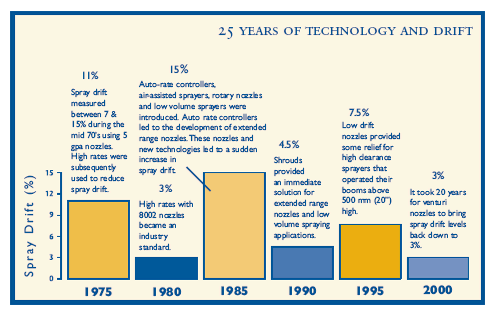| | From crop safety, economic, legal liability and environmental aspects, minimizing drift is a key element of truly sustainable crop protection.
.
The AgTech Centre has used wind tunnel simulation along with extensive field-scale research to evaluate key sprayer technologies for reducing spray drift in typical in-crop, disease control and desiccant technologies.

The history of nozzles
The story of spray drift is the history of nozzles itself. Auto-rate controllers introduced in the 1980s led to the development of extended range nozzles. These nozzles and new technologies, such as low volume sprayers, led to a sudden increase in spray drift of up to 15 percent. Since then, researchers have been targeting spray drift as an area for needed improvement.
Nozzle research with specially designed field-scale sprayer equipment that represents a range of sprayer types has generated some interesting results in the bid to reduce airborne spray drift.
Key points include:
- Low pressure venturi nozzles, such as Air Bubble Jet and Airmix, reduced drift by 35 to 60 percent compared to preorifice nozzles. For best coverage, these nozzles should be operated between 150 and 400 kPa (20 and 60 psi), averaging around 275 kPa (40 psi) but usually not lower than 200 kPa (30 psi.)
- High pressure venturi nozzles, such as TurboDrop and AI TeeJet, reduced drift by 60 to 90 percent compared to pre-orifice nozzles. They can be operated at 275 to 825 kPa (40 to 120 psi), with an average of 525 kPa (75 psi) but not lower than 275 kpa (40 psi).
- If spray drift is a concern, nozzles should be operated at the low end of the range of pressure for the nozzle. If extra coverage is needed, nozzles can be operated at the high end of the pressure range.
- High pressure venturi nozzles are best suited for high clearance sprayers if drift is the primary concern. The nozzles produce a coarser droplet size, which has a lower risk of drift when higher spray booms are used. Low pressure venturi nozzles are sufficient with pull-type equipment.
- Shrouds are still needed. The combination of a conventional sprayer equipped with low pressure venturi nozzles and a shroud produces optimum drift reduction at higher wind speeds.
The bottom line on drift
Venturi nozzles brought spray drift levels back down to the range seen in the early 1980s. While improved sprayer technology has helped reduce spray drift dramatically in recent years, the war on spray drift is not over.
Farmers want to use lower water rates for economic and practical reasons and as a result must make a compromise between coverage and drift. Until farmers don’t have to chose between those, technology will continue to be developed and applied as weapons against drift. It’s up to producers to use the best technology available for the specific spraying situation.
Industry drives sprayer Web resource for farmers
The AgTech Centre is one of a number of industry players involved in a new sprayer technology research and information resource called Canada Sprayer Guide.
Located at www.canadasprayerguide.com, Canada Sprayer Guide is designed to help producers, and those who serve producers, keep up to date on the latest developments in crop protection technology with a theme of technology for a sustainable industry.The goal of the Guide is to provide common sense, realistic advice on this important area of agricultural production.
Maintaining connections with industry plays an important role in the research and extension of the AgTech Centre. This industry site complements resources such as Ropin’ the Web www.agric.gov.ab.ca and the Alberta Agriculture, Food and Rural Development’s call centre at 310-FARM. |
|